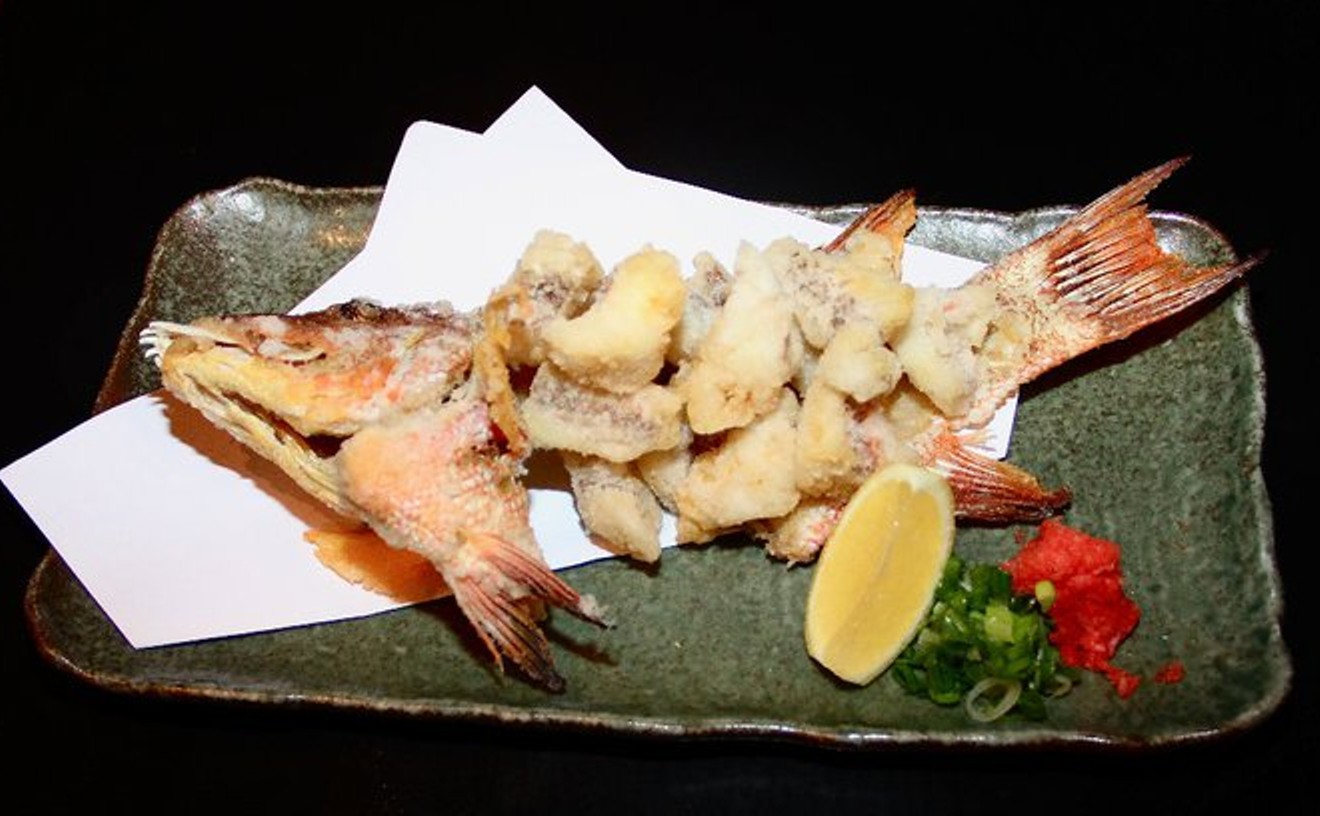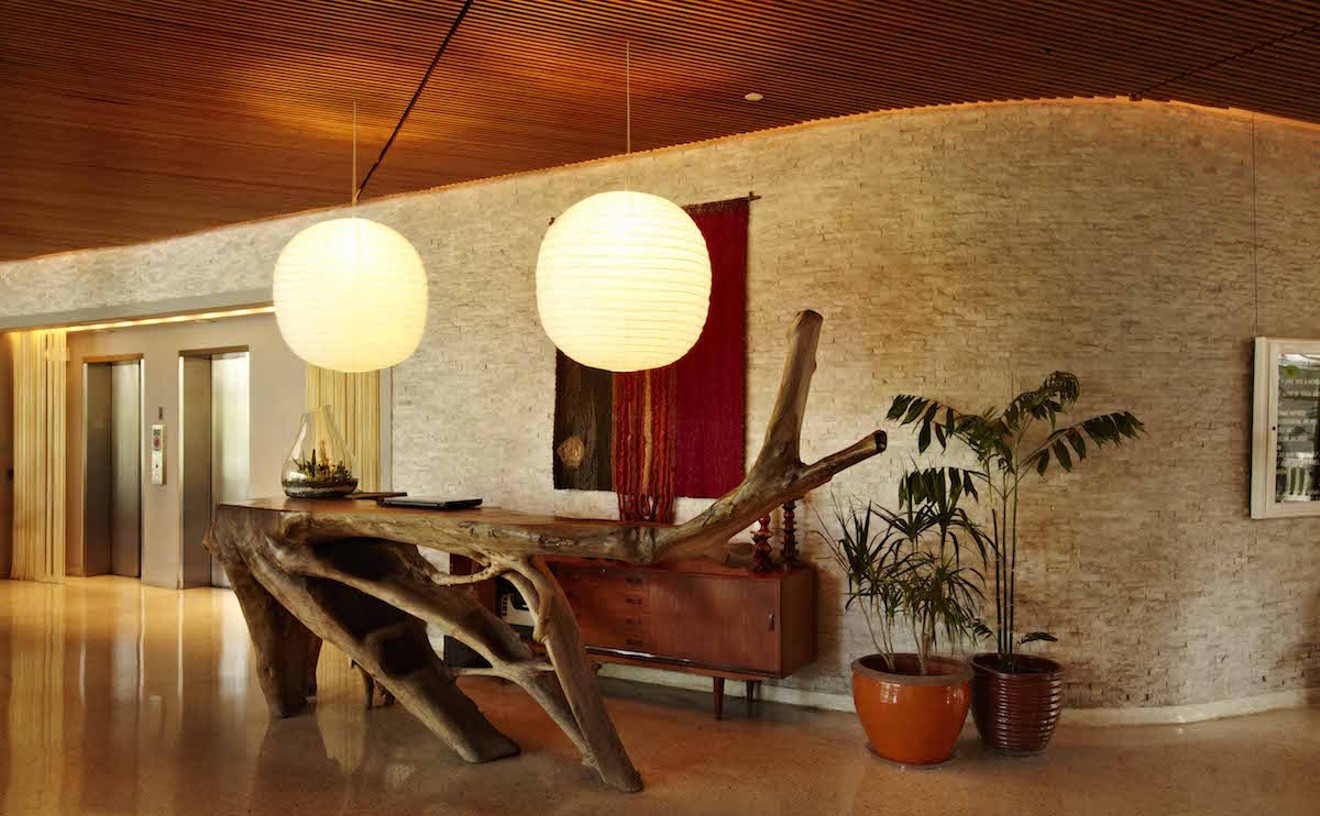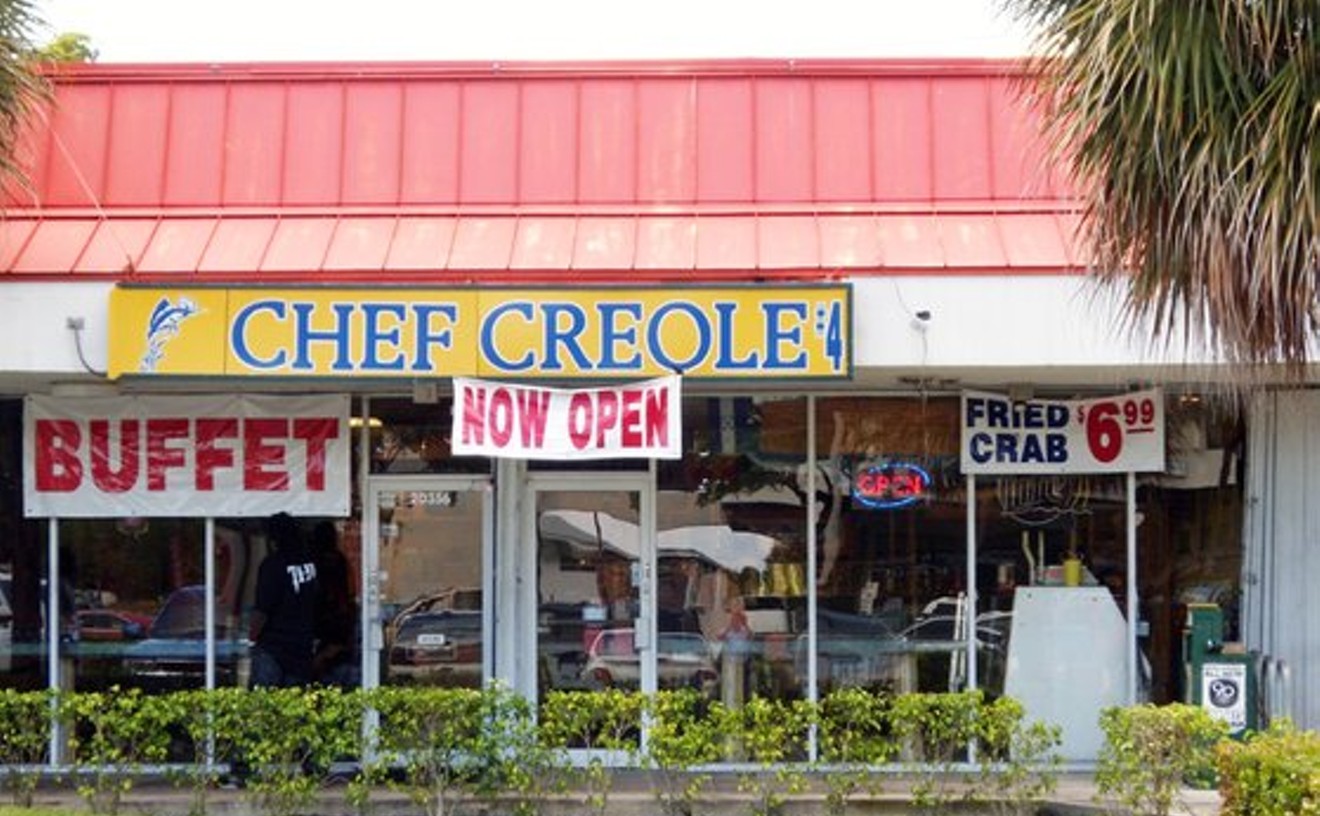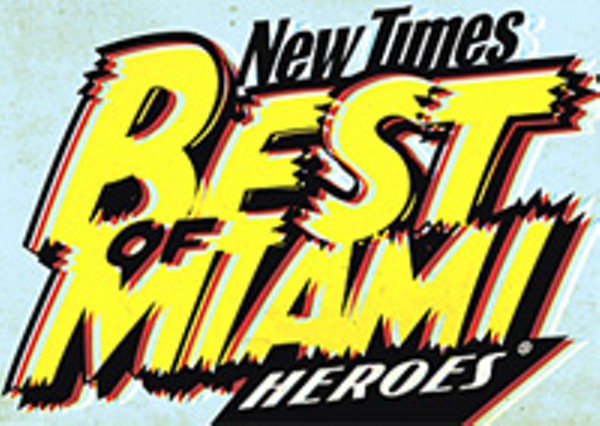Best Late-Night Dining
Hiro's Yakko-San

Yakko Bistro photo
Most late-night spots stay open to serve revelers who just don't want to go home, and the menus reflect this purpose — burgers, burritos, pizza, and Denny's-diner-type crap. Fuck that. Some of us who dine past midnight aren't drunk or drugged when doing so. In other words, we can taste the food. This holds especially true for those sushi chefs from South Miami to Broward County who take the late-night drive to Yakko-San after they pack their knife kits up at their respective Japanese restaurants. It is in order to accommodate these chefs that Hiro's stays open until 3:30 a.m. on the weekends (2:00 during the week), and it is something of a gift that the rest of us are invited to take advantage as well. You'd be surprised how many people do. Since opening in 2000, Yakko has become an enormously popular destination, the sparse, 60-seat room filled at all hours with folks enjoying traditional Japanese food freshly cooked and presented in no-frills, small-plate servings (and eminently affordable, with hardly an item over $10). Instead of the burger: crystalline chrysanthemum leaf tempura. In place of the burrito: piquant kimchee hot pot with pork, tofu, and baby clams. And as a pizza substitute: okonomiyaki, described as "Japanese pizza, veggies, egg on brown sauce, mayo" (really more of a fried pancake/omelet, but it will do the trick). Late-night revelers needn't miss a beat either — two dozen sake selections should help keep the party going. Speaking of which — Hiro's Yakko-San sleeps in, opening for dinner at 6:00 p.m. Readers' Choice: Denny's
- 17040 W. Dixie Highway, North Miami Beach, 33160 Map
- 305-974-5632
- yakkobistro.com
Best Mofongo
Papa Rudy's Restaurant & Cafeteria
Mofongo is urban street lingo for bold and sassy in demeanor; a sultry or delicious presence; an attitude. As in: I mean like, damn son, dat bitch gots crazy mofongo, word up, all sorts of wanting to tap dat, for real ... mmm.... This colorful slang derives from the traditional Puerto Rican specialty of mashed plantains mixed with garlic and other flavorings and fried up in a pan. It can be served plain, as a side dish, but when it's stuffed with chicken, beef, or some other meat, mofongo becomes an entrée — bold, sassy, sultry, etc. In the center of the island it's often made with pork. On the coast, it is almost always stuffed with fresh fish or shellfish. At the informal, inexpensive Papa Rudy's, they serve it plain, stuffed with shrimp, stuffed with churrasco steak, stuffed with pork chicharrones, stuffed with fried chicken chops, and stuffed with grilled chicken breast ($7.25 to $19.95). For the past nine years, nobody has been making a better version of this starchy mash than Papa Rudy. Mmm ... dass nice, kid.
Best Fish Market
Captain Jim's Seafood
While patrons at Garcia's and Casablanca's fawn over the Miami River, residents of the landlocked north swear by Captain Jim's. While it may lack the waterfront vista that inspires seafood lovers with the morbid satisfaction of eating something just killed, don't be fooled by the fish emporium's out-of-the-way location. Captain Jim Hanson maintains a fleet in Key Largo that guarantees fresh fish every day, much of it finding its way to high-end restaurants around town. His island know-how comes through in the conch — as fritters ($5.99), in a salad ($3.95), or cracked ($6.95 for a starter, $10.95 for a main-course portion).What's more, the adjoining market offers an ample selection of fish that can be fileted to your liking at no extra cost. The selection, though not always the most abundant in town, proves consistently cheap and choice. If you're tired from the drive, pick a fish out of the market, take a seat in the restaurant, and have the friendly staff prepare it however you choose.
Best Natural Foods Restaurant
A
Named after a New York City subway line, and no larger than a subway car, counterculturish couple Blue and Marc Solomon's A is a convivial neighborhood café steeped in young, bohemian flavor. The "organic French-Carribean" cuisine is hippie-dippie tasty, beginning with appetizers such as d'anjou pear baked with roquefort and honey, and vegetable terrine layered with spinach and red pepper mousse. Entrées like ratatouille-tofu crpe with papaya provenal, and a robust ragoût of forest mushrooms, seitan, and white beans will heartily sate any vegetarian's appetite, while lamb merguez sausages with couscous will keep the carnivore in the corner quiet. No dish exceeds $12 at this funky, dinner-only locale, and the BYOB wine policy courteously comes sans corkage fee — so dinner with wine comes on the cheap. Naturally.
Best Fresh Seafood
Matsuri
Madonna once ate here. Best fresh seafood. Case closed. What — the material girl's endorsement isn't good enough for you? You're demanding more evidence before agreeing with us that Matsuri makes other seafood restaurants seem a little fishy by comparison? Well, all right, but if you don't mind our saying so, you're acting a little divalike. Opened in 1988, this suburban strip-mall sushi spot sports an extensive selection of raw seafood specialties as fresh as those found in a fish market. All the familiar rolls are available, along with specialties like otoro, the Kobe beef of the sea (a steal at $4 per piece). Sushi quality is high high high, prices low low low. Matsuri tosses together topnotch tempura and teriyaki, too, as well as some traditional Japanese seafood dishes that you can't find anywhere else — from shisamo (salt-broiled freshwater smelts) to nama uni (custardy sea urchin) to ankimo ponzu ae (monkfish liver, or "Japanese foie gras"). Best fresh seafood. Case closed. Plus, Madonna once ate here.
- 5759 Bird Rd., Miami, 33155 Map
- 305-663-1615
- www.matsurimiami.com
Best New Dining Trend
Use of locally grown foods
The national buzzword among health-conscious diners used to be organic. It still is, to some extent, but as large corporations and supermarket chains increasingly dominate the organic food market, local has become the focus. It's the closest we, as urban dwellers, can come to eating fruits and vegetables grown in our back yards — and in a way, the Redland and farmlands of Homestead are our collective back yard. That Miami chefs have so enthusiastically embraced this trend is encouraging for numerous reasons. First, buying food directly from local family farms puts fresher, less processed products on our restaurant plates, and promotes sustainable and humane practices — while nonlocal food is often linked with heavy subsidies, poor animal welfare, lack of care for the environment, and poor working conditions. Second, we are blessed to be living so near to fertile farmlands that produce not only fine tomatoes, strawberries, and such, but an array of tropical fruits few other American cities can come close to — close being the operational word here. And finally, it's a sign of Miami's maturity into a relevant American food city that our chefs are so in sync with what is going on gastronomically elsewhere in the country. Even just a couple of years ago, this wasn't the case. Think globally. Buy locally. Can ya digç
Best Crabcake
Fifty Restaurant

The ramifications of a perfect crabcake were, admittedly, underestimated by all to a vast degree. Who could have foreseen that when chef Roly Cruz-Taura first unveiled his masterpiece at Fifty Restaurant, a progressive American newcomer to South Beach's Ocean Drive, it would be so creamy and juicy, and crammed with peeky toe crab sealed tightly in paper-thin, phyllolike, fried green plantain skin, for $12ç Who would prophesy that the entire population of the state of Maryland would swoon in envyç Or that the citizenry of Baltimore would take it especially hard, and contemplate a class action suicideç And it is still difficult to believe those rumors about the soft shell crabs threatening to boycott our waters — something about there not being enough room in this town for two sensationally unique crustaceansç Why, that just sounds crazy! Maybe it's the dab of avocado aioli atop the crabcake that puts everyone over the edge, or the smooth beurre blanc pooled below. One can only shudder to think of the chaos that will ensue if the perfect slice of pizza is ever created.
- 444 Ocean Dr., Miami Beach, 33139 Map
- 305-532-2441
Best Nonvegetarian Restaurant for Vegetarians
Lido at the Standard

Adrian Gaut/The Standard Spa
An utter lack of decent vegetarian restaurants in our area dictates that noncarnivores must compromise and seek the next best thing: nonvegetarian dining establishments that respect and cater to those who don't eat meat. Problem is, there aren't too many of these, either, and even fewer that go beyond good intentions to actually create great meatless meals. Luckily we have Lido, located in the splendidly sun-kissed Standard Hotel and Spa. Superstar chef Eric Ripert was originally paid big bucks to draw up the menu here, but the results proved surprisingly small. Enter Lido's nonsuperstar chef Mark Zeitoni, who wisely trashed Ripert's ripoff and replaced it with a selection of light, luscious, spa-worthy creations. We assure you: No animals are harmed during the preparation of puréed pumpkin soup with nutmeg-flecked cauliflower flan ($7) or beet carpaccio with watercress and aged sherry vinaigrette ($11). And that's just for starters. For main course, diners can choose a threesome from a list of greens and grains, then mix and match them with any of a half-dozen sauces ($18). For instance, the Italian grain farro comes tossed with rosemary and parmesan, and can then be sprinkled with some truffle vinaigrette — or you may opt to splash it with sundried tomato and citrus sauce instead. Perhaps you'll select grilled haricots verts with lemon and sea salt to go along, and top it with a dab of yellow tomato béarnaise sauce, and finish the plate with quinoa and dried fruit — not sure what sauce you'd choose with that one, but to have to grapple with such a dilemma is a vegetarian's delight. So are salubrious salads and other lunch options served alfresco by the picturesque bay.
- 40 Island Ave., Miami Beach, 33139 Map
- 305-673-1717
- standardhotels.com/spa-miami-beach
Best Conch Fritters
Chef Creole

For some reason there's an unspoken rule among many Miami restaurant owners to include some variation of conch fritters on their menus. Most of them possess the requisite crunchy exterior and soft interior; but few compare to the fritters that fly out of Chef Creole. The size and shape of a smashed tennis ball, peppery and delicious, these deep-fried delicacies represent fritters at their finest. For $4 you get four, and though they're scrumptious and spicy on their own, for extra zing, try them with Chef Creole's homemade pikliz sauce — made of hot peppers, vinegar, cabbage, and other secret ingredients. A tip: Follow the fritters with an order of sweet plantains, and your tongue will thank you.
- 13105 W. Dixie Highway, North Miami, 33161 Map
- 305-893-4246
- www.chefcreole.com
Best Pizza Joint
Frankie's Pizza

No seats, no atmosphere, no booze. A menu shorter than Paris Hilton's attention span. A location only a strip mall developer could love. No amenities or accoutrements, no bells, whistles, or dancing bears. Only the best goddamn pizza on the planet. For 52 years, six days a week (Mondays off), Frankie's has been dishing up pies that are as elemental in their construction as they are satisfying. Nothing fancy here; you won't find smoked salmon pizzas or Thai chicken pizzas. Frankie's toppings are simple and offer few choices —tomato sauce, meats, veggies, cheese. They're all good enough. But what makes Frankie's pizzas the best on the goddamn planet is the crust—a little crunchy, a little chewy, remarkably light, with a faint char from the oven, and tasting of fresh-baked bread. Better still, a large deluxe tops out at $20. Who needs atmosphereç
- 9118 Bird Rd., Miami, 33165 Map
- 305-221-0221
- www.frankiespizzaonline.com





